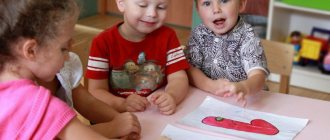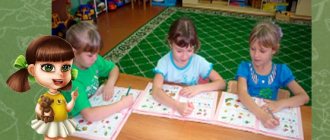Speech development in children of senior preschool age
Consultation for parents and educators on the topic:
“Speech development in children of senior preschool age”
Teacher – speech therapist: Tkalicheva G.V.
Tomsk 2022
Topic: “Speech development in children of senior preschool age”
Tasks:
Expand parents' knowledge about the speech characteristics of children of the 6th year of life;
To form parents’ knowledge about the importance of developing children’s correct speech;
Introduce parents to games aimed at developing children’s correct speech.
Speech development is the most important acquisition of a child in preschool age. Well-developed speech makes it easier to perceive knowledge acquired in kindergarten, at school, at home, and helps in communicating with peers and adults.
A child with well-developed speech easily enters into communication with the outside world. He can clearly express his thoughts, desires, and consult with peers, parents, and teachers. A child’s unclear speech makes it difficult to communicate and imposes many complexes on the child’s character that will require the attention of specialists such as a speech therapist, speech pathologist, psychologist and others. A child with undeveloped speech has a decline in curiosity, which is especially characteristic of preschool age.
In our time of development of information technology, the development of speech is important. Children know how to use this technique, but they cannot show their speech creativity. Children know how to communicate with each other, but not everyone is able to express their speech in class (situational conversation).
In older preschool age, the most intensive development of speech occurs. A child's vocabulary increases from two hundred to several thousand words. The sound aspect of speech is also improved. Children can correctly reproduce hissing, whistling and sonorant sounds. Phonemic hearing and intonation expressiveness of speech develop.
The grammatical structure of speech is improved. Children use almost all parts of speech and are actively engaged in word creation.
Coherent speech develops. Children can retell, tell from a picture, conveying not only the main thing, but also the details.
Unfortunately, not all children develop speech in accordance with age standards; many have difficulties in mastering certain categories of speech and disturbances in the formation of speech components. I bring to your attention the most pressing problems
, characteristic of many children of senior preschool age:
1.Poor vocabulary;
2. Insufficiently formed phonemic hearing and phonemic perception: Phonemic hearing is the ability to hear and distinguish sounds in a stream of speech in a different linear order (inhale-input, sleep-nose), in words that are similar in sound, but different in meaning (heron-drop, tower-arable land Phonemic perception is sound analysis, which underlies mastery of the process of learning to read and write: this is the ability to determine the presence or absence of a sound in a word; the ability to determine the location of a sound in a word; the ability to determine the sequence of sounds and their number in a word.
Norms of speech development in a preschooler from 3 to 7 years old
The results of studies of the speech of preschoolers make it possible to establish average indicators. Let's consider what levels of speech development are expected at each age stage - for younger, middle and older preschoolers. For convenience, we present the data in a table.
Table. Approximate norms for speech development of preschool children
| Age | Lexicon | Level of speech development |
| 3-4 years | up to 1900 words | Speech is situational, using indefinite forms there, like that. Makes simple sentences. Uses verbs, nouns and pronouns (often demonstrative this, that). Pronunciation: softens the sound, does not pronounce the sound R, less often – L, K, G. replaces hissing sounds with whistling ones. |
| 4-5.5 years | 2000-2500 words | Expands the use of adjectives. Literally understands the meaning of the word. He is interested in the sound of words, composes rhymes and new consonant words. Uses diminutive suffixes. Uses conjunctions a, and, but, as well as subordinates that, when, because... Expresses quantitative and qualitative relationships: many-few, high-low... Pronunciation: overcomes softening, masters almost all sounds, partially copes with the pronunciation of R. |
| 5.5-7 years | up to 4000 words | Speech is coherent and detailed. Composes messages from several sentences united by a common meaning. Builds sentences correctly from a grammatical point of view. Modifies words using suffixes. Masters the declension of nouns and the conjugation of verbs. Sound pronunciation must be correct. |
Parents' activity in the development of their child's speech
It is important for parents to consider that each child has his own individual pace of development. Noticing problems in the development of speech in their child in the preschool period and some discrepancy with the norms, they should not jealously compare with others and catch up with their peers, at all costs. However, this issue cannot be ignored.
Parental assistance is necessary for a preschooler in cognitive and speech development. Children, with the support of their parents, successfully progress in the following areas:
- vocabulary formation
- word creation
- development of verbal description skills.
In everyday communication with a child, parents have hundreds of opportunities to use new concepts and explain what they mean. Such simple participation of adults will significantly expand the active vocabulary of a preschooler.
Word creation allows the child to better understand the language and contributes to the development of a sense of rhythm. In addition to benefits in speech development, this activity brings incredible pleasure to children. Emotional speech, joint invention of new words with mom or dad is always accompanied by laughter and a joyful mood.
Parents can successfully teach verbal descriptions to their child. An adult can tell stories and describe what is happening to a preschooler, giving an example of a coherent statement, and then invite him to similarly describe what he sees around him. These activities are easy to do and can be done in any environment - at home or on a walk.
Reasons for the delay in the formation of coherent speech in children
To determine the level of development of coherent speech, you need to analyze compliance with the age criteria listed above, that is, make a kind of diagnosis. It should be carried out in a playful way, without focusing the child’s attention on the result, without making comments, without correcting, without teaching. Just create a situation and observe the behavior and speech of a preschooler.
Difficulties and difficulties in speech development can occur in children for medical reasons:
- pathology of intrauterine development (mother's exposure to infectious diseases, intense toxicosis);
- birth injuries (asphyxia, premature birth, infection, etc.);
- childhood head trauma, especially in the area of speech zones;
- hearing or speech impairment (the latter is diagnosed by age 5).
There are also social reasons that slow down the development of coherent speech in a child:
- pedagogical neglect - they do not work with the child or the child exhibits behavioral disorders (“difficult child”);
- lack of communication in a family - the lack of direct, close communication between all its members, when several people simply exist under one roof;
- change of place of residence, especially in a foreign-language environment - if at home they speak one language, in a child care center and on the street - in another, the child experiences difficulties in mastering speech skills.
Excessive care can also lead to speech delays, since the child simply does not need to speak if his wishes are guessed and instantly fulfilled.
As a rule, by the age of 5-6 years a child can:
- consistently answer questions;
- compose short narratives based on illustrations;
- describe your impressions of what you saw;
- convey the content of what was heard or seen from memory;
- come up with a continuation of a fairy tale, fantasize.
But in order for the result to meet age requirements, it is necessary to pay enough attention to communication and activities with the child at each stage of growing up.
Speech development disorders and their prevention
Most often in older preschoolers these disorders manifest themselves in incorrect pronunciation. There are several types of violations:
- dyslalia - incorrectly pronounces individual sounds, which is quickly eliminated with the help of a speech therapist;
- dysarthria - articulation and voice formation are impaired, the help of a neurologist is needed;
- rhinolalia - incorrect pronunciation of sounds, the voice is monotonous, slurred, the help of an otolaryngologist is needed;
- motor alalia - children understand everything, but cannot speak coherently, incorrectly agree words by gender, number, case;
- sensory alalia - children do not understand the meaning of words addressed to them, they need the help of a neurologist, psychiatrist, speech therapist-defectologist;
- aphasia - a disorder due to neuroinfection or traumatic brain injury;
- reactive mutism - the child used to speak, but then abruptly stopped due to a neurological disease;
- stuttering - lack of fluency of speech, a 6-year-old child repeats syllables and sounds, speaks intermittently.
Another group is speech delay (SD) against the background of mental disorders (MD).
Prevention of disorders by a speech therapist
To prevent problems in a 7-year-old child, it is necessary to develop him from early childhood: talk to him, show him, name objects, read fairy tales, nursery rhymes, sing songs, develop fine motor skills.
The help of a speech therapist would be helpful. It helps the little patient develop articulatory and fine motor skills; cognitive processes, skills of analyzing what is heard.
What is “connected speech”?

An utterance or coherent speech is several complete segments (sentences) that are connected thematically, in meaning, and in structure. It serves to facilitate communication and is expressed in two forms:
- monologue - the ability to talk about a certain image, action, etc.;
- Dialogue is direct interaction with another person or people through communication.
Statements are the result of perception, comprehension, and the ability to express one’s thoughts. Coherent speech gives a clear understanding of the relationship between a child’s mental and speech development and helps solve problems in all areas of upbringing and education.
Monologue speech of older preschoolers consists of several main types:
- description - includes the general name of the object (action), a listing of its properties, qualities, and in conclusion - an assessment or attitude towards it (parts of this structure can be rearranged);
- narration is a statement of fact in which the beginning of the story, its culmination, outcome or denouement is clearly visible;
- reasoning is a separate type of statement that reflects a certain connection of events, facts, phenomena (consists of a statement, evidence, conclusion).
All these variants of coherent speech are found in children in a mixed form.
The initial and most important stage in the development of coherent speech in children is dialogue. It reveals the specifics of interaction, allows you to convey to the child the norms and rules for the further construction of monologue speech according to the laws of the literary language.
In order to correctly organize work on the formation of coherent speech in preschoolers, it is necessary to know the stages of its development, as well as to identify the main tasks for each type of speech separately.
Learning to write and read
Moms and dads strive for their child to learn to read and write as early as possible. But psychologists and neurologists do not recommend doing this. Firstly, the child must master new skills in a timely manner (and earlier does not always mean better), and secondly, children need to be taught using a special method. It is owned by kindergarten teachers and primary school teachers, but parents can make many mistakes and only harm their child.
Instead, focus on preparing to master new skills.
Learn sounds. Moms and dads often teach their children letters, but this is wrong. Words are built not on letters, but on sounds.
Train your articulation apparatus. This is the key to correct pronunciation.
Learn to write in block letters, not in capital letters. Schools use the continuous writing method. Other techniques will only do harm; the student will have to relearn, and this is much more difficult.
Get your little hand ready to write. Let him draw, cut out, hatch, paint, put together a mosaic, draw dots on checkered paper - this trains fine motor skills, muscles, and develops spatial orientation.
Let's talk separately about the sound-letter analysis of words. This is where preschoolers begin to be taught to read.
Learn to read step by step
Stage one - learning sounds.
- Start by learning a group of sounds. Use a primer or alphabet - learn in the same sequence.
- Tell us about vowels and consonants. How to pronounce them (drawn out, abruptly), how they differ.
- Tell us about syllables. Show how you can make a syllable from two sounds. Talk about the difference between letters (they are written) and sounds (they are pronounced). Show examples, for example “ma”, “sha”, “ra”, “ma”.
- It is correct to teach your child: “b”, “p”, “v”, and not the letters “be”, “pe”, “ve”. Otherwise, the daughter or son will read letter by letter: “Me - a - sha - a”, place “Ma-sha”. It will be more difficult and longer for him to learn to read by syllables, then by words. Complex words will even look like puzzles: “a - ve - te - o - be - y - es” instead of “av-to-bus” is much more difficult to perceive.
Stage two - read:
- We learn to combine sounds into syllables. Task for the baby: pronounce the first sound in the word until he reads the second: “m-m-m-m-a-a”;
- Finding syllables in a word. Assignment: ask your son or daughter to find certain combinations of letters in a word. Let him read them;
- We make up new words. Ask your child to make up a few words from familiar syllables and read them;
- Adding sounds. The baby adds one sound to familiar syllables, reads, composes new syllables, words;
- Learning to read closed syllables. First, show the difference between an open (“ka”) and a closed (“an”) syllable.
If the preschooler has completed these stages successfully, you can complicate the task - move on to more complex words, and then to sentences.
Pay attention to the fact that the child puts the emphasis correctly and understands the meaning of the words read. If he doesn’t understand, explain. Practice in the form of a game.




